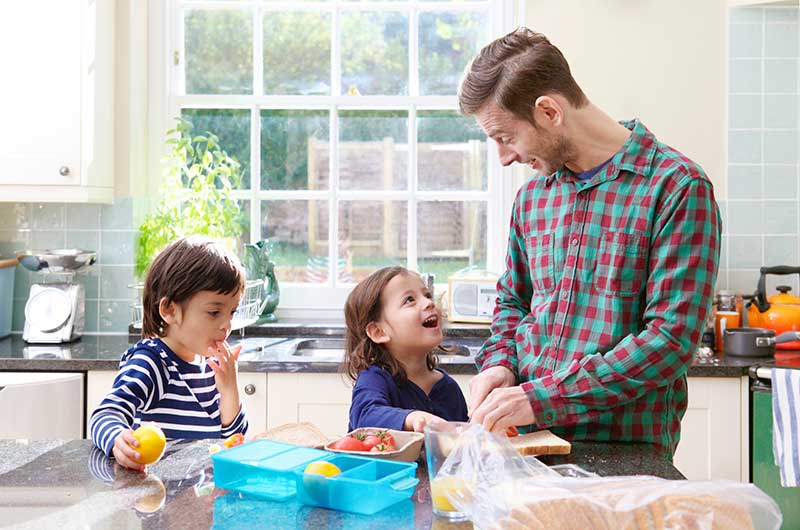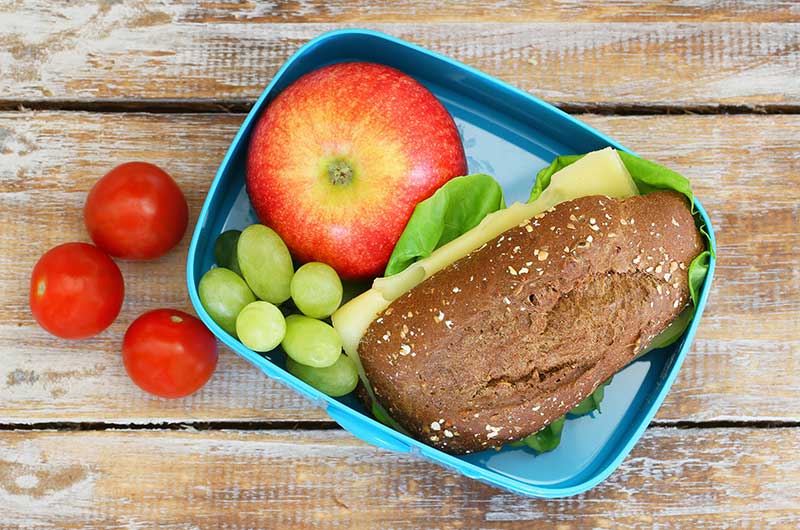Last Updated July 19, 2024 (originally published August 23, 2016)
|
Key Takeaways Packing healthy school lunches can be challenging for any parent, as you’re forced to balance the desire to make the process simple with budgetary concerns and a child’s food preferences. Learn how working together as family, offering options and making gradual changes can be the keys to success. In addition, this blog offers nutritious lunch ideas and some simple food swaps that you can begin making right away. Back to school season is upon, so use these strategies to make the transition a healthy one. |
Packing healthy school lunches can be challenging due to lack of time, your child’s food preferences and habitual patterns that often drive decision-making. For example, you may be in the habit of buying single-serving bags of chips and tossing them into the lunchbox. After all, it satisfies your kid’s cravings and makes your morning routine a bit easier—no decisions and no prep. One of the keys to packing a healthier lunchbox—or making any behavior change—is to keep things simple. Read on for strategies and suggestions.
Three Tips for Lunch Sack Success

Work together.
Healthy habits start at home, so build a strong foundation. Knowing that your other family members are all on the same page strengthens the collective effort. Social support is a major factor when it comes to implementing healthy behaviors. Pack lunches with the whole family for the whole family.
Create options.
Pick a few different healthy foods to replace the less nutritious ones (examples are below). Everybody likes to feel in control. Keep it simple with two choices. Set guidelines and boundaries, and then let everyone make the choice that’s most appealing to them.
Brainstorm meal ideas together over the weekend for the week to come. Ask kids for their input. Find out what they like and why. It’ll keep them more connected to the mission and teach them about healthful eating. Make a game out of it by including various colors with fruits and vegetables. Include food from each group—grains, dairy, fruits, vegetables and protein. Then, go shopping together. Make it a routine, a ritual, a habit. Make it a priority.
Gradual change is more sustainable.
To increase the chances of healthy habits sticking around, don’t revamp lunchtime all at once. Replace one lunch box item at a time, week by week, and reevaluate periodically. Slow, consistent change is more successful than abrupt menu alterations. Set a focus for each week and switch up the “healthy” part of the lunch. One week it can be the main item, another the snack and the week after, the beverage.
Lunchbox Swaps

Before you switch out one food for another, consider cravings. Talk about why certain foods are so enjoyable. Creamy, crunchy, salty, sweet and savory are common sensations that draw people to various foods. Finding an alternative that fits into the same sensation category can help satisfy the desire for that food.
-
Try almonds, carrots or celery instead of chips or pretzels. There is still a crunch, but the nutrients are higher in the healthy stuff.
-
Introduce flavored water instead of soda. Add a splash of fruit juice, lime, lemon, fresh fruit or mint.
-
Choose hummus or avocado instead of mayo on a sandwich. Get the creamy and moist texture with higher quality foods.
-
Enjoy some plain yogurt swirled with vanilla and honey instead of artificially flavored yogurt or ice cream.
-
Snack on grapes, apples, peaches, dried mango or other fruit instead of candy to satisfy the sweet tooth.
-
Indulge in a piece of dark chocolate or nuts instead of a candy bar.
Reward Yourself

Health reasons aside, these food swaps can give your kids more energy and increase their focus throughout the school day. When you begin incorporating these swaps into your family’s routine, celebrate together! Find a common treat for the family to enjoy each week or month. A healthy cooking class or a fun physical activity, for example, will promote family fitness beyond lunchtime.
To learn more about how to build healthy habits for you and your family, check out these two ACE blogs:




 by
by 








 by
by